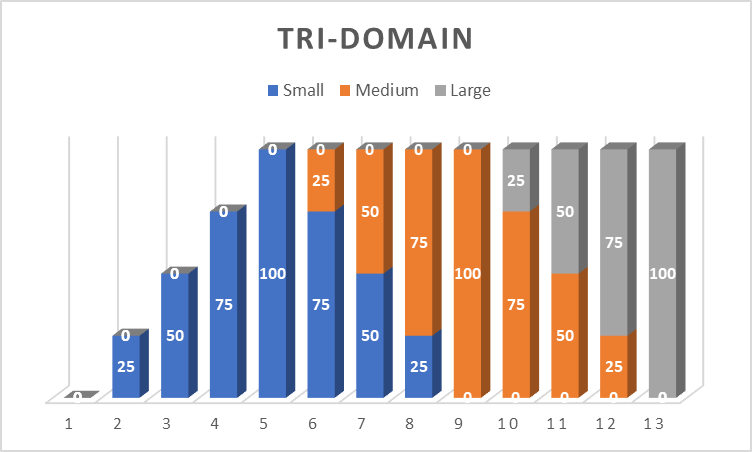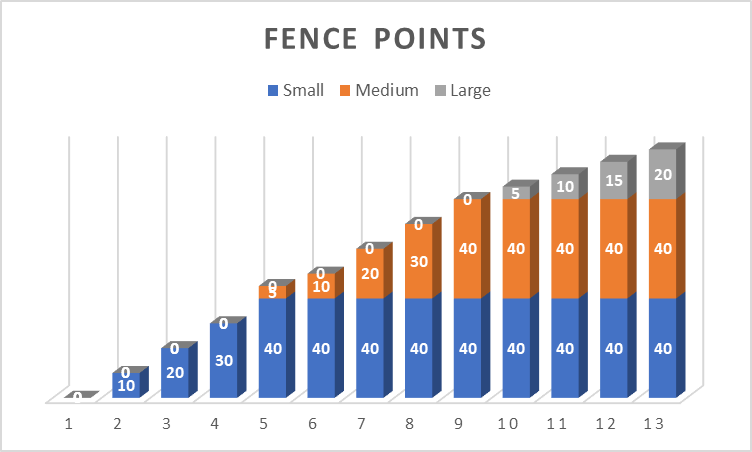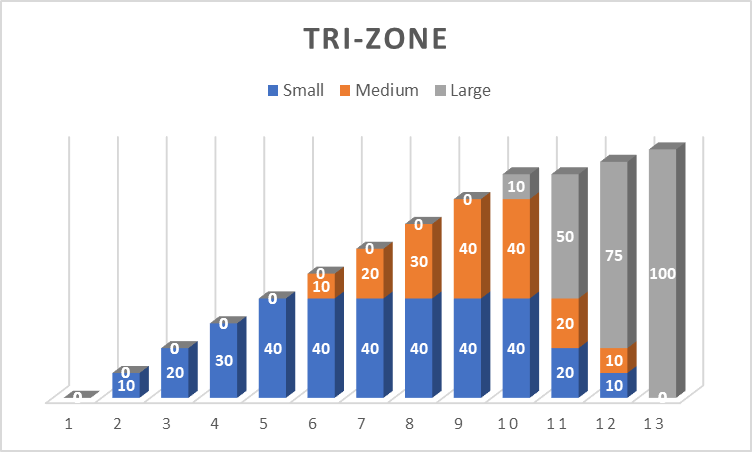Note: These materials are offered only in English as supplementary examples for a deeper dive into
Tri-Zone Screening
Tri-Zone screening offers the benefits of both Fence Points and Tri-Domain screening.
These screening systems are for 2-bit devices (printers capable of small, medium, and large dots).
The way we use the difference dot sizes will vary the shades of colors (lighter and less dense or darker and more dense).
Before explaining how Tri-Zone works, it's important to understand Fence Points and Tri-Domain screening.
Tri-Domain

The above image shows a typical small, medium, and large dot size usage for Tri-Domain screening.
Tri-Domain is a 2-bit screening system developed to ensure the printer prints the maximum amount of ink it can. This is especially important with direct-to-garment.
It makes use of the complete range of small, medium, and large dots. At 100%, you get the maximum available ink coverage.
This does have some disadvantages;
- In general, a large coverage of only small dots is more likely to show visible banding issues.
- As you get to higher density, the ideal method is to use a mixture of all three dot sizes as much as possible to keep the banding minimized (while this is not possible if you want maximum ink coverage, this method means we only ever use two dot sizes at any given shade).
Fence Points

Fence Points is a 2-bit screening system designed to use a mixture of all the three dot sizes.
This is generally recommended to:
- Help reduce banding.
- Work as an ink limiting system
The main down side of the Fence Points system is when you need a lot of large dots, then the range of small and medium dots is reduced.
For example, if you need 70% large dots to get a good density of primary (CMYK) and secondary (RGB) colors, then the number of small and medium dots is limited to a range of just 30%.
Tri-Zone

Tri-Zone is a 2-bit screening system designed to combine the benefits of Fence Points and Tri-Domain screening, without the disadvantages.
In a Tri-Zone screening system, you can select the range of small and medium dots, as well as control the amount of ink used at the 100% coverage.
In the example above, you can have a full coverage of large dots without using the full range of small and medium dots (reducing banding in these areas). This provides Tri-Domain coverage with the added Fence Points benefit of controlling small and medium dot usage.
Tri-Zone can be used to control ink limiting (as with Fence Points). However, a wider range of small and medium dots are used than with Fence Points.
The graph is an approximation of how the different dot sizes are used.
Dot volumes between small, medium, and large dot sizes are not linear. To get the best ICC profile, it's important to aim for a linear change in ink volumes, which ensures better gradients, better color, and transitions between color.
Recommended: To get a good linear ink volume increase, use the presets.
You can set the values manually, but this is not recommended without a strong knowledge of the printer and ink volumes of the different dot sizes.
The preset affects all the values for small and medium dots, transition and coverage.
Presets:
- Small Dots Max - Set the level of coverage for all small dots (value is between 0 and 255).
- Small Dots Min - Small dots are used to ensure 100% coverage.
- Small Dots Transition - Small and medium dots are mixed for a clean transition between dot sizes.
For example, with Small Dots Max set to 87 with a transition of 60, there is a mixture of small and medium dots between 87 and 147. - Medium Dots Max - Set the level of coverage for medium dots (value is between 0 and 255).
- Medium Dots Min - Medium dots are used to ensure 100% coverage.
- Medium Dots Transition - Medium and large dots are mixed for a clean transition between dot sizes.
- % Overall Coverage - Edit the percentage of pixels used for coverage without changing the ratio of small, medium, and large dots.
For example, at 50%, only 50% of the pixels have dots.